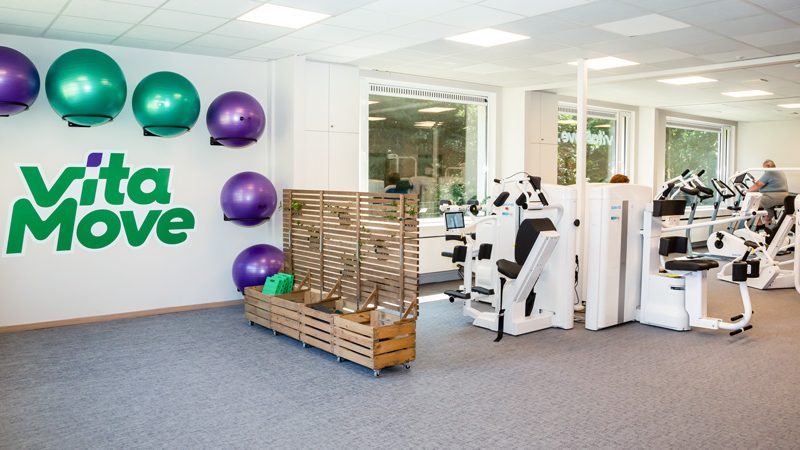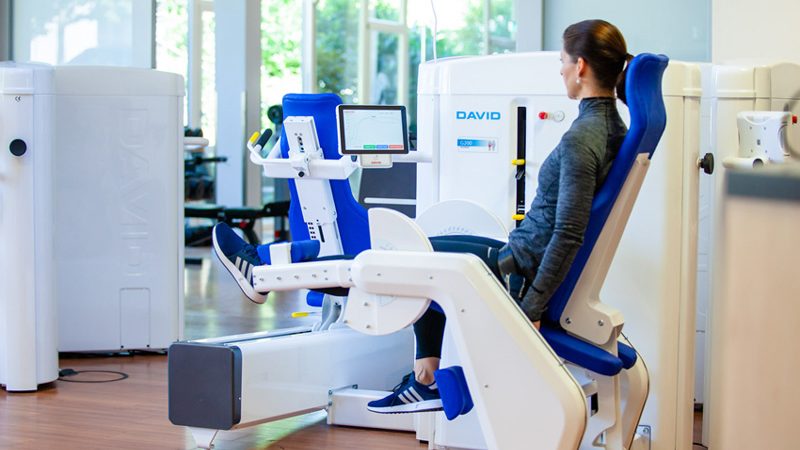The core set of clinical outcome measures for the first six weeks after hospital discharge or illness from COVID-19 at home consists of:
- Patient-Specific Functioning Scale (PSFS) to determine the perceived physical limitations in participation and activities of daily living.
- Borg Scale CR10 for Shortness of Breath and Fatigue indicating shortness of breath and fatigue experienced by the patient. A maximum threshold score for exercise intensity of 4 out of 10 on the Borg Scale CR10 applies at this time after illness.
- Oxygen saturation (SpO2 ) at rest, during and after physical activity, and therapeutic exercise. If the physiotherapist has a pulse oximeter, it can be delivered to the patient’s home, when treatment is provided remotely.
- Heart rate (HR) at rest, during and after physical activity, and therapeutic exercise. In the case of e-health consultation, heart rate can be measured by instructing the patient on how to measure it himself, for example using the Version 2.0 / 27 July 2020 15 KNGF position statement: Recommendations for physiotherapy in patients with a COVID-19 pulse oximeter or by instructing the patient how to measure it themselves with the heart rate indicated by the patient (‘counting strokes aloud’). The physiotherapist should be aware that outcomes can be influenced by medication.
- Short Physical Performance Battery (SPPB) to measure balance, muscle strength, and mobility. The SPPB consists of a balance test, walking speed over 4 meters and 5 times repeated standing up from a chair test. The physiotherapist must at all times ensure the safety of the patient if they are (seriously) weakened. In the case of e-health consultation, the SPPB cannot be performed.
- Grip Strength to estimate overall peripheral muscle strength. If possible and available, a hand-held dynamometer is used.
- 6-Minute Walk Test (6MWT) to estimate exercise capacity. In the case of e-health consultation or the patient has (very) low exercise tolerance levels, the 6MWT should not be attempted.
- Short Nutritional Assessment Questionnaire (SNAQ65+) for early detection of malnutrition in patients who have been hospitalized. The physiotherapist uses the SNAQ65+ to identify a potential malnutrition status of the patient. A dietician should be consulted or referred to in case of signs of malnutrition. It is important that the physiotherapist and dietician have good communication and collaboration.
In this position statement, the clinical outcome measures focus on physical functioning. Optionally, during the first six weeks, a pedometer/accelerometer can be used to determine and monitor daily physical activity levels. Also, one-repetition maximum (1RM) tests can be used to determine muscle strength of specific muscle groups and to determine initial intensities of exercises that improve muscle strength (Table 1).
| Construct | Patient with (very) low exercise tolerance levels* | Patient with increased exercise tolerance levels* |
| Activities and participation in ADL | PSFS | PSK |
| Perceived fatigue | Borg Scale CR10 for Shortness of Breath and Fatigue | Borg Scale CR10 for Shortness of Breath and Fatigue |
| Perceived breathlessness (dyspnea) | Borg Scale CR10 for Shortness of Breath and Fatigue | Borg Scale CR10 for Shortness of Breath and Fatigue |
| Oxygen saturation | transcutaneous oxygen saturation (SpO2 ) | transcutaneous oxygen saturation (SpO2 ) |
| Heart rate | Heart rate measurement | Heart rate measurement |
| Muscle strength lower extremity | SPPB; repeated stand up from chair test (5x) | SPPB; repeated stand up from chair test (5x), 1 RMδ |
| Muscle strength upper extremity | Grip strength | Grip strength, 1 RMδ |
| Balance | SPPB; balance test | SPPB; balance test |
| Mobility | SPPB; 4-meter timed walk test | SPPB; 4-meter timed walk test |
| Physical activity level | pedometer/accelerometerδ | pedometer/accelerometerδ |
| Exercise capacity | – | 6MWT |
| Nutritional status | SNAQ65+ | SNAQ65+ |
Besides physiotherapy specific assessment and treatment, the physiotherapist plays an important role in identifying factors that may limit (the speed of) recovery, in particular in case the patient is not also monitored by the GP or hospital. Factors to be aware of include nutritional status, cognitive and emotional functioning and psychosocial functioning. A multidisciplinary approach may be necessary when such factors are present.
The physiotherapist plays an important role in identifying factors that may limit recovery.
The decision on specific clinical outcome measures also depends on collaboration with other healthcare disciplines.[27] Use of different clinical outcomes for the same constructs by different healthcare professionals should be avoided to facilitate interdisciplinary communication and monitoring of the patient, and not burden the patient unnecessarily.
| Core set of clinical outcome measures ‘first six weeks’ |
| • Use the Patient-Specific Functioning Scale to identify perceived limitations in activities of daily living.
• Use the Borg Scale CR10 to monitor shortness of breath and fatigue. • Before, during, and after physical activity and exercises, monitor the patient’s oxygen saturation and heart rate. • Use the Short Physical Performance Battery (SPPB) to measure balance, muscle strength, and mobility. • Use grip strength measurements (handheld dynamometer) to estimate overall peripheral muscle strength. • Use, when safe, 6-minutes walk test (6MWT) to estimate the exercise capacity. • Use the Short Nutritional Assessment Questionnaire (SNAQ65+) for early identification of potential malnutrition in patients who have been hospitalized. |
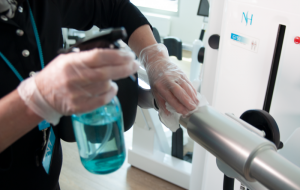
1. Advice and coaching
It is important to provide information and educate the patient about the disease process, the expected course of recovery, and the physiotherapy treatment plan. If the physical functioning of the patient is limited, the physiotherapist advises and coaches the patient to gradually increase physical functioning. For example, postural advice to promote breathing and to reduce tightness, mobilizing exercises aimed at activities of daily living, and exercise to improve the strength of large muscle groups. In patients with (very) low exercise tolerance, for example, those with PICS, resuming daily activities in the home environment should be gradual and well monitored. Activities of daily living and supporting therapeutic exercises should be performed at low to moderate intensity and be of limited duration at this stage. See further recommendations for exercise prescription below.
| Advice and coaching |
| • Provide information and educate the patient about the disease process, the expected course of recovery, and physiotherapy treatment plan
• Advise and coach the patient to gradually increase activities of daily living and physical activity, such as therapeutic exercises. Monitor the patient’s levels of daily functioning. •In patients with (very) low exercise tolerance, activities of daily living and additional exercise therapy should be performed at low to moderate intensity and be of short duration (see further recommendations for exercise prescription below). |
Exercise prescription Specific parameters for exercise prescription depend on activity levels of the patient prior to the COVID-19 infection, the patient’s needs, and the current physical abilities of the patient. In the first six weeks, the emphasis is on returning to activities of daily living. A maximum score of 4 out of 10 on the Borg Scale CR10 for Shortness of Breath and Fatigue is recommended. Reasons for this recommendation are:
- COVID-19 can severely impact lung function (including oxygen desaturation during exercise due to virus-induced and/or pre-existing lung disease).
- COVID-19 can severely affect cardiac function (including virus-induced myocarditis, arrhythmia, and/or pre-existing cardiac disease).
After the active COVID-19 infection, no maximal exercise testing is done, partly due to organizational limitations in hospitals due to the corona crisis. Adequate clinical information to determine patient-specific training parameters for exercise prescription is therefore not available, nor is it possible to estimate the possible risk of physical training at a moderate/high intensity.
Physiotherapy focuses on activities of daily living and aims to gradually increase muscle strength, balance, endurance, and/or relaxation. To ensure energy for daily activities throughout the day, it is important to consider the patient current status and their wishes and to help them plan their activities, therapeutic exercises, and resting periods over the length of the day. The recommendations in this Position statement are generic and need to tailored to the patient’s ability and needs.
During exercise, it is important that oxygen saturation (SpO2 ) is monitored to identify potential desaturation. Therefore, measure oxygen saturation prior to, during and immediately after exercise training or physical activity in the home situation, in particular when patients experience breathlessness or fatigue. Whenever possible, the patient should use a pulse oximeter at home. The physiotherapist can provide guidance on the correct use of the pulse oximeter by the patient themselves. Use 90% of SpO2 at rest and 85% of SpO2 during exercise or physical activities as lower limits. Stop physical activities or exercises when desaturation (SpO2 < 85% during exercise) occurs. In case the saturation level is decreasing, it is important that the saturation level reaches its pre-activity level, measured at rest, within two minutes.
Intensive monitoring of oxygen saturation is not indicated when patients have no signs of desaturation in the first two weeks of increasing exercise intensity. Treatment focuses on gradually increasing activities of daily living, muscle strength, balance, exercise endurance, and/or relaxation. For each therapy goal, recommendations are given for frequency, intensity, type and time/duration (FITT components). The recommendations describe different types of exercise. These are mere examples, and should not be considered as a protocol. The physiotherapist must consider for each individual patient their goals, related types of exercise, and their parameters.
| Exercise prescription |
| • Focus on activities of daily living.
• In the first six weeks focus on a gradual increase in physical functioning; use a maximum score of 4 out of 10 on the Borg Scale CR10 for Shortness of Breath and Fatigue. • Monitor oxygen saturation and heart rate prior to, during, and immediately after exercise training. • Stop physical activities or exercises when desaturation (SpO2 < 85% during exercise) occurs. In case the saturation level is decreasing, it is important that the saturation level reaches its pre-activity level, measured at rest, within two minutes. • Let patients only perform physical exercises in the home situation with prescribed training parameters regarding frequency, intensity, time/duration, and type. |
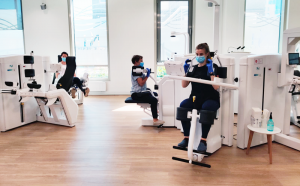
2. Improving the level of activities of daily living
Exercise prescription to increase activities of daily living depends on the patient’s request for guidance and their physical abilities. For example, the first step could be moving in bed and getting out of bed independently. The second step could focus on exercises to improve independent physical functioning in their home environment. The third step is to help independent physical functioning outside their home environment. At which step to start highly depends on the patient’s current abilities. Therefore, the exercise plan can differ for each patient.
Examples of exercises to gradually increase activities of daily living
| Step 1 (very low exercise tolerance) | |
| Frequency | daily |
| Intensity | the maximum score of 4 out of 10 on the Borg Scale CR10 for Shortness of Breath and Fatigue |
| Type | bridging, rolling onto one side, sitting on the bed (potentially with assistance) |
| Time/duration | The total duration of the session: 5-20 minutes |
| Step 2 (low exercise tolerance) | |
| Frequency | daily |
| Intensity | the maximum score of 4 out of 10 on the Borg Scale CR10 for Shortness of Breath and Fatigue |
| Type | Standing up from a chair, walking (e.g. to the toilet) (with walking aid if necessary), walking stairs (a few steps) |
| Time/duration | The total duration of the session: 5-20 minutes |
| Step 3 (increased exercise tolerance) | |
| Frequency | daily |
| Intensity | the maximum score of 4 out of 10 on the Borg Scale CR10 for Shortness of Breath and Fatigue |
| Type | Walking short distances or use a (stationary) bike with low resistance, activities outdoors (e.g. grocery shopping) |
| Time/duration | Start with a total duration of 5-20 minutes, gradually increase duration depending on the patient’s abilities |
Improving muscle strength and balance
Exercise prescription to increase muscle strength and balance highly depends on the abilities and tolerance levels of the patient. Muscle strength exercises should focus on large muscle groups of the lower extremities and upper extremities and core stability.
Examples of exercises to gradually increase
| Lower extremities | |
| Frequency | 2-3 days per week, to increase and maintain muscle strength |
| Intensity | the maximum score of 4 out of 10 on the Borg Scale CR10 for Shortness of Breath and Fatigue, estimation: 40-60% of 1RM |
| Type | Closed chain, open chain, and dynamic exercises, possibly with own body weight as resistance. |
| Time/duration | per exercise 2-5 sets of 8-15 repetitions with at least 2 minutes rest between sets |
| Upper extremities | |
| Frequency | 2-3 days per week, to increase and maintain muscle strength |
| Intensity | maximum score of 4 out of 10 on the Borg Scale CR10 for Shortness of Breath and Fatigue, estimation: 40-60% of 1RM |
| Type | Closed chain, open chain and dynamic exercises, possibly with own body weight as resistance. |
| Time/duration | per exercise 2-5 sets of 8-15 repetitions with at least 2 minutes rest between sets |
| Core stability | |
| Frequency | 2-3 days per week, to increase and maintain muscle strength |
| Intensity | maximum score of 4 out of 10 on the Borg Scale CR10 for Shortness of Breath and Fatigue |
| Type | Closed chain |
| Time/duration | per exercise 2-5 sets of 8-15 repetitions with at least 2 minutes rest between sets |
| Balance | |
| Frequency | 2-3 days per week, to increase and maintain balance |
| Intensity | maximum score of 4 out of 10 on the Borg Scale CR10 for Shortness of Breath and Fatigue |
| Type | Balance exercise in sitting or standing position |
| Time/duration | Total duration of the session: 5-20 minutes |
3. Improving exercise endurance
Exercise prescription to increase exercise endurance highly depends on the abilities and exercise tolerance levels of the patient. The frequency, intensity, type and duration can therefore differ per patient.
Examples of exercises to gradually increase exercise endurance
| Frequency | 2-3 days per week, to increase and maintain exercise endurance |
| Intensity | maximum score of 4 out of 10 on the Borg Scale CR10 for Shortness of Breath and Fatigue, lower limit of oxygen saturation level of 85% during exercise and/or physical activity |
| Type | endurance, preferably on a treadmill or stationary bike* |
| Time/duration | Total duration of the session: 5-20 minutes |
* In case a treadmill or stationary bike is not available, walking outdoors can be considered if deemed safe. In patients with (very), low exercise tolerance levels in-bed cycling can be considered.
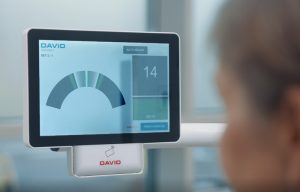
4. Improving breathing
Exercise prescription to improve breathing is dependent on whether the patient has breathing problems. Only if there is any indication, breathing exercises should be prescribed. There are two types of breathing exercises: control of breathing and respiratory muscle strength. Control of breathing Consider these breathing exercises in patients with shallow or paradoxical breathing. Shallow breathing is characterized by an increased respiratory rate (> 25 breaths/minute) and incomplete exhalation. Signs of paradoxical breathing are retraction of the abdomen on inhalation and expansion of the abdomen on exhalation. Note: Consider pursed-lip breathing in patients with COPD and hyperinflation and/or Hoover’s sign.[28] Respiratory muscle strength This type of exercise should be performed in patients with reduced muscle strength of respiratory muscles. [29] Whether a patient has reduced respiratory muscle strength has often been determined during hospitalization and physiotherapy has commenced there. In these patients, exercise prescription should be continued using the previously determined maximum respiratory muscle strength values and existing training advice. This type of breathing exercise should not be started if the maximum values of the respiratory muscle strength are not known. During respiratory muscle training, the inspiratory and expiratory pressures may be equivalent to those performed during a pulmonary function assessment. Therefore, contraindications for respiratory muscle training are the same as those for respiratory muscle testing.[30,31] It is important to contact the referring hospital or GP if there are any concerns or doubts about (relative) contraindications for respiratory muscle training and measurement.
Examples of exercises to improve breathing
| Control of breathing | |
| Frequency | Daily |
| Intensity | Maximum relaxation, minimal shortness of breath and fatigue respiratory rate 6-12 breaths per minute |
| Type | Diaphragmatic breathing or respiratory volume exercises |
| Time/duration | Total duration of the session: 5-20 minutes |
Examples of exercises to improve breathing
| Respiratory muscle strength | |
| Frequency | 3 times per day, preferably in the morning, afternoon and evening |
| Intensity | maximum score of 4 out of 10 on the Borg Scale CR10 for Shortness of Breath and Fatigue, respiratory rate < 15 breaths per minute, estimation: 30-50% of maximum respiratory muscle strength |
| Type | inspiratory and expiratory muscle strength training |
| Time/duration | Total duration of the session: 5-20 minutes, up to 30 breaths per session |
5. Improving relaxation
The prescription of exercises to improve relaxation depends on the patient’s request for help. Patients who experience shortness of breath, have sleeping problems, are stressed, and/or have high muscle tone may benefit from relaxation exercises. Such exercises help to relax the whole body and to facilitate good posture; these relaxation exercises are not specific for breathing control.
Examples of exercises to improve relaxation
| Relaxation exercises | |
| Frequency | daily |
| Intensity | Maximum relaxation, minimal shortness of breath and fatigue |
| Type | Simple relaxation according to Mitchell’s method[32], or progressive relaxation according to Jacobson’s method [33] |
| Time/duration | Total duration of the session: 20 minutes |
| Mobilisation and relaxation exercises | |
| Frequency | daily |
| Intensity | Maximum relaxation, minimal shortness of breath and fatigue |
| Type | Exercises according to Dixhoorn ‘s method |
| Time/duration | per exercise: 2-5 sets of 8-15 repetitions, with at least 2 minutes rest after each set |
| Exercise prescription |
| • Treatment focuses on gradually increasing activities of daily living, muscle strength, balance, exercise endurance and/or relaxation.
• If there is an indication, breathing exercises can also be prescribed. • The physiotherapist must consider for each individual patient their request for guidance, individual goals and experienced limitations. Based on this, types of exercise and their parameters should be chosen. Therefore, the exercise plan can differ of each patient. |
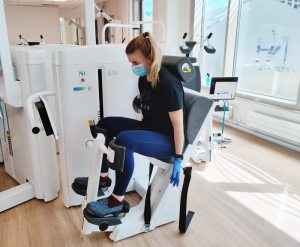
6. Signs of physical and/or psychological distress
Signs of physical and/or psychological distress in the patient can be noted during physiotherapy treatment. In these cases, the physiotherapist should act adequately and adjust the treatment accordingly. Possible signs of distress and how the physiotherapist can act if such signs are present are shown in the table below.
| Signs | How to act |
| Not able to talk during exercises/ physical activity | Lower the intensity, use adequate resting periods |
| Borgscale score of 5 (out of 10) prior to the treatment session or at the end of the day, could indicate ‘extreme fatigue’ | Advise the patient to not perform exercises or physical activity at those moments |
| Dysfunctional breathing; changes in breathing pattern can occur when coming to an erect/vertical position or when exercising. This can trigger fear of acute breathlessness | Consider relaxation and breathing exercises, cognitive therapy and/or psychoeducation |
| Confusion, residual cognitive problems (memory, concentration, processing stimuli) | When patients expect or experience difficulty resuming or increasing work (activities) and/or maintain energy for daily activities throughout the day, consider collaboration with or referral to an occupational therapist. |
| Anxiety or trauma-related distress: nightmares, flashbacks, feeling rushed or nervous, sleeping problems, worrying, feeling tense, quickly emotional, indeterminate anxiety, anxiety or panic attacks | Assess these potential signs, for example using the GPS or the 4-DSQ. Consult with the GP or a psychosomatic physiotherapist if the signs indicate anxiety or trauma-related complaints. |
| Mood changes: feeling sad, depressed, dreary, without energy, nervous, worthless; decreased interest or pleasure in activities, decreased concentration; recurring thoughts about death | Assess these potential signs, for example using the 4-DSQ. Consult with the GP or a psychosomatic physiotherapist if the signs indicate serious mood changes. |
| Psychological distress/overload: feeling irritable, restless, rushed and/or tense, worried, mentally unstable; not being able to cope with crowds/noise | Assess these potential signs. Consult with the GP or a psychosomatic physiotherapist if the signs indicate psychological distress/overload. |
| 4-DSQ = Four-dimensional symptom questionnaire; GPS = ‘Global Psychotrauma Screen’ |
This position statement has been developed by the Royal Dutch Society for Physical Therapy (KNGF) together with a national working group of experts in the field of physiotherapy, from a patient association (Longfonds) and the Dutch Lung Association (Long Alliantie Nederland). This position statement describes recommendations regarding physiotherapy services for patients with confirmed or suspected COVID-19 after hospital discharge or patients who have been ill at home. Recommendations in this position statement are based on international evidence and guidelines on COVID-19, expert opinion, and patient preferences.
References
- Zhou F, Yu T, Du R, Fan G, Liu Y, Liu Z, et al. Clinical course and risk factors for mortality of adult inpatients with COVID-19 in Wuhan, China: a retrospective cohort study. Lancet. 2020;395(10229):1054-62.
- Phelan AL, Katz R, Gostin LO. The novel coronavirus originating in Wuhan, China: Challenges for global health governance. JAMA – J Am Med Assoc. 2020;323(8):709-10.
- National Institute for Public Health and the Environment (RIVM). [Verspreiding nieuw coronavirus (COVID-19)] [in Dutch]. 24 July 2020. Available via: https:// www.rivm.nl/ coronavirus/covid-19/verspreiding.
- National Institute for Public Health and the Environment (RIVM). [Actuele informatie over het nieuwe coronavirus (COVID-19)]. [Internet]. [in Dutch]. 24 July 2020. Available via: https:// rivm.nl/coronavirus-covid-19/actueel.
- National Institute for Public Health and the Environment (RIVM). [Coronavirussen] [Internet]. [in Dutch]. 24 July 2020. Available via: https://www.rivm.nl/ coronavirus.
- Letko M, Marzi A, Munster V. Functional assessment of cell entry and receptor usage for SARS-CoV-2 and other lineage B betacoronaviruses. Nat Microbiol [Internet].2020;5(4):562-9.
- Sohrabi C, Alsafi Z, O’Neill N, Khan M, Kerwan A, Al-Jabir A, et al. World Health Organization declares global emergency: A review of the 2019 novel coronavirus (COVID-19). Int J Surg [Internet]. 2020;76(February):71-6.
- National Institute for Public Health and the Environment (RIVM). [Het virus (SARCCoV-2)] [Internet]. [in Dutch]. 24 July 2020. Available via: https://www.rivm.nl/ coronaviruscovid-19/virus.
- National Institute for Public Health and the Environment (RIVM). [De ziekte COVID-19] [Internet]. [in Dutch]. 24 July 2020. Available via: https://www.rivm.nl/ coronaviruscovid-19/ziekte
- Chang D, Mo G, Yuan X, Tao Y, Peng X, Wang F, et al. Time kinetics of viral clearance and resolution of symptoms in novel coronavirus infection. Am J Respir Crit Care Med. 2020;201(9):1150-2.
- Moore KA, Lipsitch M, Barry JM, Osterholm MT. COVID-19: The CIDRAP Viewpoint; Part 1: The future of the COVID-19 pandemic: Lessons learned from pandemic infl uenza [Internet]. April 2020. Available via: cidrap.umn.edu.
- Remuzzi A, Remuzzi G. COVID-19 and Italy: what next? Lancet [Internet]. 2020;395(10231):1225-8.
- Wu Z, McGoogan JM. Characteristics of and important lessons from the coronavirus disease 2019 (COVID-19) outbreak in China: summary of a report of 72314 cases from the Chinese center for disease control and prevention. JAMA – J Am Med Assoc. 2020;323(13):1239-42.
- Tingbo L. Handbook of COVID-19 prevention and treatment [Internet]. Handbook of Covid-19, prevention and treatment. 2020. p. 68. Available via: https:// covid-19.alibabacloud.com.
- Livingston E, Bucher K, Rekito A. Coronavirus disease 2019 and infl uenza 20192020. JAMA – J Am Med Assoc. 2020;323(12):1122.
- Felten-Barentsz KM, van Oorsouw R, Klooster E, Koenders N, Driehuis F; Hulzebos EHJ, et al. Recommendations for hospital-based physical therapy treatment of patients with COVID-19. Phys Ther J. June 2020.
- Terpos E, Ntanasis-Stathopoulos I, Elalamy I, Kastritis E, Sergentanis TN, Politou M, et al. Hematological findings and complications of COVID-19. Am J Hematol. 2020;1-14
- Poissy J, Goutay J, Caplan M, Parmentier E, Duburcq T, Lassalle F, et al. Pulmonary Embolism in COVID-19 Patients: Awareness of an Increased Prevalence. Circulation. 2020;1–6.
- Li YC, Bai WZ, Hashikawa T. The neuroinvasive potential of SARS-CoV2 may play a role in the respiratory failure of COVID-19 patients. J Med Virol. 2020;92(6):552–5.
- Needham DM, Davidson J, Cohen H, Hopkins RO, Weinert C, Wunsch H, et al. Improving long-term outcomes after discharge from intensive care unit: Report from a stakeholders’ conference. Crit Care Med. 2012;40(2):502-9.
- Vitacca M, Mauro Carone, Enrico Clini, Paneroni M, Lazzeri M, Lanza A, et al. Joint statement on the role of respiratory rehabilitation in the COVID-19 crisis : the Italian position paper. AIPO Ric Ed – Milano. 2020;1-17.
- Ad-hoc Taskforce European Respiratory Society (ERS), version April 3rd 2020, Available via: https://www.ersnet.org/covid-19-blog/covid-19-and-rehabilitation
- Driehuis F, Meerhoff G, Vreeken H, Swart H, van Doormaal M, Post M. [KNGFrichtlijnenmethodiek 2019: Ontwikkeling en implementatie van KNGF-richtlijnen] [in Dutch] Royal Dutch Society for Physical Therapy (KNGF), Amersfoort, 2019. Available via: https://www.kngf.nl/kennisplatform/guidelines
- Dutch Association for Medical Specialists (FMS). [Leidraad Nazorg bij ICpatiënten met COVID-19, 10 april 2020] [in Dutch]. Available via https://www. demedischspecialist.nl/ sites/default/fi les/Standpunt%20Nazorg%20COVID19.pdf.
- Dutch Association for Medical Specialists (FMS). [Leidraad Nazorg bij patiënten met COVID-19, 28 mei 2020] [ in Dutch]. Available via: https://www. demedischspecialist.nl/ sites/default/files/Leidraad%20Nazorg%20COVID-19.pdf.
- International Classification of Functioning, Disability and Health. Genève, Zwitserland: WHO; 2001.
- Dutch Association of Rehabilitation physicians (VRA), [Advies basisset klinimetrie nazorgpoli, versie 30 april 2020], [in Dutch]. Available via: https:// revalidatiegeneeskunde. nl/coronavirus-en-revalidatie-sector.
- Royal Dutch Society of Physical Therapy (KNGF). KNGF-guidline COPD [in Dutch], KNGF Amersfoort. Available via: https://www.kngf.nl/kennisplatform/richtlijnen/ copd-2020
- Bisselt B, Gosselink R, van Haren FMP, Respiratory muscle rehabilitation in patients with prolonged mechanical ventilation: a targeted approach. Crit Care. 2020;24:103.
- Laveneziana P, Albuquerque A, Aliverti A, Babb T, Barreiro E, Dres M, et al. ERS Statement on respirator muscle testing at rest and during exercise. Eur Resp Journal, 2019;53
- Cooper BG, An update on contraindications for lung function testing. BMJ Thorax. 2011;66:714-23.
- Mitchell, L. Simple Relaxation – The physiological method for easing tension, 1977, John Murray, London
- Jacobson, E. Progressive Relaxation, 1939, University of Chicago Press.
- Royal Dutch Society for Physical Therapy (KNGF), KNGF position statement: Recommendations for physiotherapy in patients with COVID-19, July 2020, Amersfoort, the Netherlands
 English
English 
























